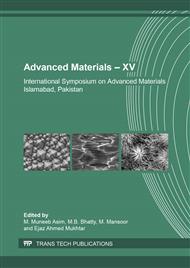[1]
M. Beidaghi and C. Wang, Micro-Supercapacitors Based on Interdigital Electrodes of Reduced Graphene Oxide and Carbon Nanotube Composites with Ultrahigh Power Handling Performance, Adv. Funct. Mat., 22 2012 4501-4510.
DOI: 10.1002/adfm.201201292
Google Scholar
[2]
D. Pech, M. Brunet, H. Durou, P. Huang, V. Mochalin, Y. Gogotsi, et al., Ultrahigh-power micrometre-sized supercapacitors based on onion-like carbon, Nat. Nanotech. 5 2010 651-654.
DOI: 10.1038/nnano.2010.162
Google Scholar
[3]
Y. Zhu, S. Murali, M. D. Stoller, K. Ganesh, W. Cai, P. J. Ferreira, et al., Carbon-based supercapacitors produced by activation of graphene, Sci., 332 2011 1537-1541.
DOI: 10.1126/science.1200770
Google Scholar
[4]
D. C. Marcano, D. V. Kosynkin, J. M. Berlin, A. Sinitskii, Z. Sun, A. Slesarev, et al., Improved Synthesis of Graphene Oxide, ACS Nano, 4 2010 4806-4814.
DOI: 10.1021/nn1006368
Google Scholar
[5]
W. Gao, N. Singh, L. Song, Z. Liu, A. L. M. Reddy, L. Ci, et al., Direct laser writing of micro-supercapacitors on hydrated graphite oxide films, Nat. Nanotech. 6 2011 496-500.
DOI: 10.1038/nnano.2011.110
Google Scholar
[6]
M. F. El-Kady, V. Strong, S. Dubin, and R. B. Kaner, Laser scribing of high-performance and flexible graphene-based electrochemical capacitors, Scie., 335 2012 1326-1330.
DOI: 10.1126/science.1216744
Google Scholar
[7]
M. F. El-Kady and R. B. Kaner, Scalable fabrication of high-power graphene micro-supercapacitors for flexible and on-chip energy storage, Nat. Commun., 4 2013 1475.
DOI: 10.1038/ncomms2446
Google Scholar
[8]
Z. Peng, J. Lin, R. Ye, E. L. Samuel, and J. M. Tour, Flexible and stackable laser-induced graphene supercapacitors, ACS Appl. Mat. Interf., 72015 3414-3419.
DOI: 10.1021/am509065d
Google Scholar
[9]
J. Lin, Z. Peng, Y. Liu, F. Ruiz-Zepeda, R. Ye, E. L. Samuel, et al., Laser-induced porous graphene films from commercial polymers, Nat. Commun., 5 2014 5714.
DOI: 10.1038/ncomms6714
Google Scholar
[10]
J. B. In, B. Hsia, J.-H. Yoo, S. Hyun, C. Carraro, R. Maboudian, et al., Facile fabrication of flexible all solid-state micro-supercapacitor by direct laser writing of porous carbon in polyimide, Carb., 83 2015 144-151.
DOI: 10.1016/j.carbon.2014.11.017
Google Scholar
[11]
L. Jiao and R. Gorby, Laser scribed graphene for energy storage application, in Opto-Electronics and Communications Conference, 2015, pp.1-3.
DOI: 10.1109/oecc.2015.7340265
Google Scholar
[12]
L. Q. Tao, H. Tian, Y. Liu, Z. Y. Ju, Y. Pang, Y. Q. Chen, et al., An intelligent artificial throat with sound-sensing ability based on laser induced graphene, Nat. Commun., 8 2017 14579.
DOI: 10.1038/ncomms14579
Google Scholar
[13]
M. Kaempgen, C. K. Chan, J. Ma, Y. Cui, and G. Gruner, Printable thin film supercapacitors using single-walled carbon nanotubes, Nano lett., 9 2009 1872-1876.
DOI: 10.1021/nl8038579
Google Scholar
[14]
Q. Chen, X. Li, X. Zang, Y. Cao, Y. He, P. Li, et al., Effect of different gel electrolytes on graphene-based solid-state supercapacitors, RSC Adva., 4 2014 36253-36256.
DOI: 10.1039/c4ra05553e
Google Scholar
[15]
M. Inagaki, N. Ohta, and Y. Hishiyama, Aromatic polyimides as carbon precursors, Carb., 61 2013 1-21.
DOI: 10.1016/j.carbon.2013.05.035
Google Scholar
[16]
J. Lin, C. Zhang, Z. Yan, Y. Zhu, Z. Peng, R. H. Hauge, et al., 3-dimensional graphene carbon nanotube carpet-based microsupercapacitors with high electrochemical performance, Nano lett., 13 2012 72-78.
DOI: 10.1021/nl3034976
Google Scholar


